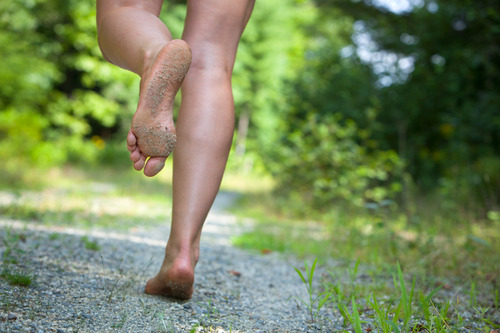Most of us consider sneakers to be an essential part of our workout gear, but one group of runners has decided to forgo this mainstream piece of exercise equipment entirely. Barefoot runners are quickly gaining in numbers, and this trend doesn’t show signs of slowing! Barefoot running, also known as natural running or minimalism, is simply running without shoes or running in thin-soled shoes. Barefoot runners claim that this is the most natural way of running, and that it can even correct an imperfect form, which may result in fewer running injuries than those who run with shoes. But is barefoot running all that it’s cracked up to be?
What is the physiology of barefoot running?
Here’s what we do know: research shows that running barefoot forces your feet to hit the ground differently than if you were wearing shoes. Specifically, sneakers make runners strike the ground with their heel first, whereas running barefoot changes the gait to a forefoot strike. This is because without the heel cushioning provided by running shoes, runners tend to naturally gravitate towards landing near the balls of the feet, which can actually put stress on the Achilles tendon and lead to injuries.
Is nutrition related to barefoot running?
There is also the question of whether landing near the front of the foot when you run is more physiologically effective than striking the ground with the heel first. Many barefoot runners purport that landing near the front of the foot will require less oxygen and effort and allow you to run faster for longer periods of time. However, one study showed that this may not be the case. Researchers at the University of Massachusetts Amherst found that heel-striking was the more physiologically economical running form, meaning that these runners burned fewer carbohydrates as a percentage of their energy expenditure when they struck first with their heels.
Here’s where food comes in: carbohydrates are one of your body’s best fuel sources due to the efficient way they use oxygen. In fact, they use less oxygen for every kilocalorie of energy produced than either fats or proteins, which make them an important part of your diet if you are physically active, especially if you are an endurance athlete. Your ability to exercise is limited by the amount of glucose (which comes from the carbohydrates that you eat) in your body. After about 90 minutes of exercise, your body’s supply of carbohydrates is completely depleted, which puts you at a risk for “hitting the wall,” or feeling lethargic during your endurance event. If your body doesn’t have enough glycogen to sustain you, it will start to burn fat for energy. Fat burns at a much slower rate than carbohydrates, which will slow you down. So, the heel-striking runners who burn fewer carbohydrates during exercise will have less energy than those who burn more! An InsideTracker blood analysis plan will tell you if you’re low on glucose, as well as suggest foods that will help you to fuel up optimally.
Are there any downsides to barefoot running?
For those of you who are wondering if barefoot running helps prevent or promote injuries, researchers at Brigham Young University did not find any evidence that running without shoes helps to reduce running-related injuries. However, barefoot running does come with its fair share of risks. For example, puncture wounds and infections may be more likely to occur in barefoot runners.
No matter if you’re a barefoot runner or prefer to wear sneakers, you may have encountered some amount of sarcomeric damage if you’re a runner. This just signifies that you’re muscles and skeletal system are being worked hard. Marathon runners put the greatest amount of stress on their muscular-skeletal system, and evidence of the damage can easily be found in the body. Creatine kinase (CK) is an enzyme that is located in several tissues in the body, mainly in muscle. When you are healthy and uninjured, there is a small amount of creatine kinase circulating in the blood, but when muscle damage occurs, the amount of CK in the blood can spike. Therefore, the CK in your blood can show the extent to which your muscles are over-exerted.
InsideTracker takes into consideration your age, gender, ethnicity, type of athletic activity (swimmers should have lower level of CK than soccer players), and determines your personalized range of CK. If you are too high, InsideTracker will give you several personalized options for reducing your levels of CK, including dietary changes, exercises, and supplements. You can choose the option that best fits your lifestyle and preferences.
If you’re considering switching to barefoot running, incorporate it into your routine slowly instead of ditching your shoes completely. No research exists that proves that barefoot-style running is either advantageous or harmful—it just depends on your level of comfort and personal preference. Take it easy, and monitor your bloodwork to make sure that you are not increasing your risk for injury!
Try Our Free Demo